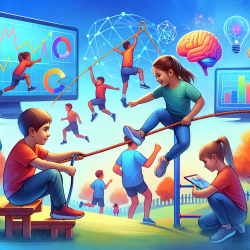Introduction
As practitioners dedicated to enhancing children's outcomes, understanding the role of motor competence in physical activity (PA) and health-related quality of life (HRQoL) is crucial. The research article "Accessing Physical Activity and Health Disparities among Underserved Hispanic Children: The Role of Actual and Perceived Motor Competence" provides valuable insights into how motor skills impact these areas, particularly among underserved Hispanic children.
Key Findings from the Research
The study explored the relationship between actual motor competence (a set of object control skills) and perceived motor competence with PA participation and HRQoL among underserved Hispanic children. The findings indicated that perceived motor competence mediates the relationship between actual motor competence and health-related outcomes. Specifically, actual motor competence significantly predicted perceived motor competence, which in turn positively predicted PA and HRQoL.
Practical Implications for Practitioners
Based on these findings, practitioners can implement several strategies to enhance motor competence and, consequently, improve PA and HRQoL among underserved Hispanic children:
- Focus on Object Control Skills: Emphasize the development of object control skills such as basketball, striking, and overhand throwing. These skills are critical for engaging in sports and other physical activities.
- Create Supportive Learning Environments: Develop a supportive and inclusive learning environment that emphasizes self-improvement rather than peer comparison. This can help build children's perceived competence and confidence in their abilities.
- Design Culturally Relevant Activities: Incorporate culturally relevant activities (e.g., basketball, baseball, football) that resonate with Hispanic children. This can increase their motivation and engagement in practicing motor skills.
- Professional Development for Educators: Provide training and professional development opportunities for school PA specialists and health promoters. This can equip them with the skills to design and implement effective PE and recess programs that promote motor competence.
Encouraging Further Research
While the study provides valuable insights, further research is needed to explore the long-term effects of motor competence on PA and HRQoL. Practitioners are encouraged to engage in or support research initiatives that investigate these relationships over time and across different populations.
Conclusion
Improving motor competence among underserved Hispanic children can have significant positive effects on their physical activity levels and health-related quality of life. By implementing the strategies outlined above, practitioners can help bridge the health disparities gap and promote better outcomes for these children.
To read the original research paper, please follow this link: Accessing Physical Activity and Health Disparities among Underserved Hispanic Children: The Role of Actual and Perceived Motor Competence.










